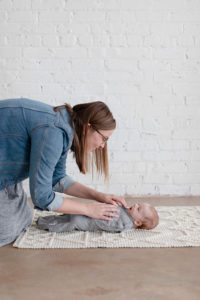When I had my oldest, I had certainly heard of “sleep training,” but the only thing I knew about sleep training was that you had to lay your baby down, walk away, and let them cry until they fell asleep (also known as the Cry-it-Out Method).
[Spoiler alert, that’s not the only sleep training method, so keep reading!]
At first, I just thought I wouldn’t have to sleep train because I had been around kids my whole life and I would just figure out baby sleep. HA!
Then when I knew it’d be a bit more than just “figuring it out,” I knew it’d be easy to let our baby cry, because again, I had been around kids my whole life, so a crying baby doesn’t bother me like it does some people. And it certainly wouldn’t last for long.
Wrong again!
That’s actually why we ended up waiting until 10 months to sleep train, because the crying was really hard for me.
It wasn’t so much that I couldn’t stand to hear her cry, but I had no clue how long she would cry, figured I must be doing something wrong, and felt helpless not being able to comfort her.
So we would let her cry for 10 minutes (sometimes 12, if we were feeling crazy), and when she wasn’t asleep (never was!), then we’d go rock her to sleep.
But at 10 months old, we had to do something more, and the only advice we were given was, “You’ll just have to let her cry,” and that’s just what we did.
Another spoiler alert: within just a few days, our baby girl was not only putting herself to sleep on her own but also sleeping through the night, which was amazing!
But I didn’t love that “just let her cry” was the only tangible piece of advice I got. You can read more about our journey toward sleep here.
One reason I became a sleep consultant was to help other parents realize that while the Cry-it-Out Method IS one way to sleep train (and it’s okay if that’s what you choose!), there are other options, and there’s way more to it than just, “let them cry.”

So today on the blog, I’m going to walk through the four main sleep training methods out there, including:
- The No-Cry Method
- The Chair Method
- Check and Console
- The Extinction Method
I will also share how you can go about picking the right sleep training method for your child and family!
1. The No-Cry Method
What is the No-Cry Method?
The No-Cry Method, or what I refer to as the Pick Up Put Down Method, is when you essentially lay your baby down, pick them up as soon as they cry, rock and cuddle them, lay them back down, and repeat until they’re asleep.
With the No-Cry Method, some people even feed or rock their babies to sleep, lay them down, then slightly wake them so the baby can “put themselves back to sleep” in their crib.
We use the Pick Up Put Down (PUPD) Method with newborns, however once babies approach the four-month mark and their sleep cycles adjust, we no longer use the PUPD method, as it doesn’t match a baby’s sleep needs and the goal of independent sleep.
There are sleep consultants out there who specialize in using a “no cry method,” and it clearly works for them, but my understanding is that it can take months for a baby to become an independent sleeper this way, so it’s not a method we use at Via Graces.
The Pros of the No-Cry Method
This sleep training method is great for parents who want little to no crying in the sleep training process and who have the time and stamina to carry out a longer method.
The Cons of the No-Cry Method
Because the No-Cry Method requires so much hands-on support, it generally takes several weeks to months before seeing success.
2. The Chair Method
What is the Chair Method?
The Chair Method, or what some refer to as the Stay-in-the-Room Method, is when you start the sleep training process with a chair in your child’s room and you stay in that chair, supporting and comforting your child, until they fall asleep.
Then over a set period of time (between 6-12 days, depending on your child’s age and what sleep currently looks like), you slowly move the chair out of the room, and eventually aren’t in there at all anymore.
When done correctly, and paired with an appropriate schedule and routines, The Chair Method usually takes about 1-2 weeks (depending on the age of the child) to see success.
We most often start by using this sleep training method when we work with families.

The Pros of the Chair Method
The Chair Method allows for quite a bit of parent interaction during the sleep training process. Parents are able to provide comfort using occasional voice, touch, and potentially some pick-ups, without doing the actual work of putting their little one to sleep.
This sleep training method does often involve crying or some protest, as that’s a baby and child’s main way of communicating that they don’t understand a change or don’t like a change, however, the parent is in there the whole time.
This is a great sleep training method for parents who only have one child, who have a partner at home who can help take care of other children, or whose older children can play independently while the parent tends to their sibling.
This is also a great method for toddlers or older children in an open bed, as it allows parents to ensure boundaries and expectations are being followed.
The Cons of the Chair Method
This sleep training method requires a parent to be in their child’s room the entire time they’re falling asleep, which also includes night wakings – this is tiring for an already tired parent!
Another challenge with the Chair Method is that for some babies, having the parent in there actually provides too much stimulation, making it even harder to fall asleep. Similarly, some parents have a harder time being in the room and hearing their child cry.
Finally, this sleep training method can also be a “slippery slope,” as it’s easy to simply pat your little one all the way to sleep, for example, because you’re already in there and “they’re just so close.”
3. Check and Console
What is the Check and Console Method?
The Check and Console method, also known as Controlled Crying (or what we refer to as Leave and Check), is when you lay your baby or toddler down, say goodnight, walk out of the room, and then intermittently come back for a brief check-in to provide comfort and support.
And then you repeat this system of leaving the room and coming back for a check-in until your little one is asleep.
With older kids, sometimes this looks like saying, “Mommy is going to get a drink of water and then I’ll come back and check on you.” Or, “Daddy is going to put the dishes away and I’ll be back to say goodnight.”
Older kids, especially, do well knowing that the length of time mom or dad is leaving is finite – they know that getting a drink of water, going to the bathroom, or putting the dishes away is fairly quick, and having that reassurance that mom or dad is coming can be helpful.
This sleep training method often involves crying or protest, as well, however as a parent does timed checks, they are able to provide brief comfort using voice and touch, and potentially a pick-up, if helpful.
When done using an age-appropriate schedule and routines, this method usually works within a week or so.
We often use this sleep training method, as well! Even if a family starts with the Chair Method, we wrap it up using Leave and Check. Similarly, if kids who have already been sleep trained are going through a regression or are having a tough night, Leave and Check is the method we fall back on.
The Pros of Check and Console
The Check and Console Method allows parents to still give their child physical comfort and support throughout the process, while also giving them space to learn to self-soothe. It also gives the parent some space from hearing their child’s direct cries.
This is a great sleep training method for parents who have other children at home and therefore cannot stay in the room with their little one the entire time it takes to fall asleep.
It also works well for parents who are comfortable with more crying yet still want to provide some physical support throughout the sleep training process.
This sleep training method is also great for little ones who are way too stimulated by having someone in the room with them the entire time.
The Cons of Check and Console
As with most areas of parenting, consistency is key. And with this sleep training method, some parents have a tough time remaining consistent with the timed check-ins (they go in sooner, or stay in longer), and like anything in parenting, consistency is key in helping a child learn to sleep.
You may be wondering: Is this the Ferber Method?
Yes, the Ferber Method is one way to do Check and Console.
The biggest difference on our end, however, is that the Ferber Method changes the time between each interval, which I find to be confusing for little ones.
So when I use the Leave and Check Method with families, we use consistent intervals of time from the get-go.

4. The Extinction Method
What is the Extinction Method?
The Extinction Method is also known as the Cry-it-Out Method. When following this sleep training method, you lay your baby down, say goodnight, and don’t go back in until morning time, no matter what.
When this sleep training method is done using age-appropriate schedules and routines, parents see success within a few days.
This is not a sleep training method we recommend when working one-on-one with families. If parents have previously used the Cry-it-Out Method and would like to continue doing so, we generally do a modified Leave and Check Method, using longer intervals between check-ins, to even just check for a dirty diaper.
(Just as a side note, the CIO method should never be used with newborns, as they do not yet have the ability to self-soothe.)
The Pros of the Extinction Method
This sleep training method can work really quickly, in just a couple of days! And it does not require the parent to respond at certain intervals or while sitting in a chair in the room, so in a sense, it’s “easy” to remain consistent – you simply don’t respond until morning.
The Cons of the Extinction Method
This is often the toughest sleep training method for parents because it is so hard to hear your little one cry and not respond. This also means it’s really hard to remain consistent with the extinction method, and consistency is key when it comes to sleep training!
What we definitely don’t want to happen is you plan to have your baby Cry-it-Out, but after 30 minutes you rock or feed them to sleep. It’s really not fair to your baby, because why would you let them cry for so long if you’re just going to put them to sleep?
It’s also not fair for you, because if you try again the next night, your babe’s “stamina,” for lack of a better term, will likely be higher as they can expect that you’ll eventually just come in and put them to sleep.
Let’s talk about the elephant in the room: Is the Cry-it-Out Method wrong?
I’m going here, because this is important. While the Cry-it-Out method certainly isn’t for everyone, it IS okay to choose this method for your family, and you are still a wonderful and loving parent who can still have an amazing attachment with your little one.
All too often people bash this sleep training method, and I’m here to say that while it’s not a favorite, it IS an option and works when done correctly.
It’s what we did with our oldest! We didn’t know there were other options and it worked. And it’s worked for many other families, as well.

How to Choose a Sleep Training Method
One of the many wonderful things about parenting is that YOU GET TO DECIDE what’s best for your child and your family. And all of the above sleep training methods I explained are all methods because they all have the possibility of working.
Think about how your little one currently falls asleep. Do you rock or feed them to sleep, or do you co-sleep? If so, the chair method would be my go-to, as they’re used to having you there and you’re used to being there.
If, however, you already leave the room as they fall asleep? It might be really confusing if you’re all of a sudden in there as they’re trying to fall asleep, leave and check might be better.
Or if your little one constantly gets out of bed at night, the chair method will be helpful to help lay down some new boundaries and instill those as they’re falling asleep.
Or if the thought of sitting right next to your baby and hearing them cry sounds awful and you’d rather leave the room and do timed checks? Then go with leave and check!
When approaching sleep training, whether doing it yourself or hiring a sleep consultant, make sure you’re comfortable with the sleep training method you’ll be using, because consistency is KEY to sleep training success!
Conclusion
When I see families who have already tried sleep training and it “didn’t work,” it’s almost always because they didn’t have a PLAN. They tried for a day or two, but it “didn’t work,” so they gave up (this happened to us a million times!).
Or they tried and tried, and remained consistent, but their schedule was off, so their child was way too tired, or not tired enough.
Or their routines were consistent, but not supportive of independent sleep, so it just wasn’t working.
So while yes, the method you choose is important, it’s also important that all of the other puzzle pieces are in place – environment, schedule, routine, etc. Put those pieces together with a sleep training method and that’s where we see success!
Wondering when would be the best time to sleep train? Check out this blog post!
If you’re reading this and want to better understand those other “pieces to the puzzle”, our A to Z classes are a great fit for you! You will learn all about newborn, baby, and big kid sleep so you can make the best choice for your little one and family.
And if you’re reading this and just want someone to walk you through step-by-step what to do first, then next, and what about the night waking, and naps the next day, what do we do when… – then our one-on-one coaching packages would be a great fit for you.
With Grace,
Lauren
